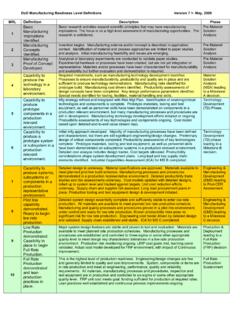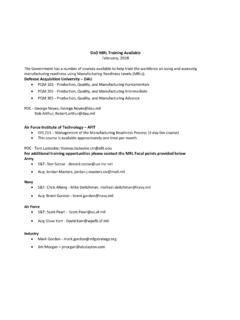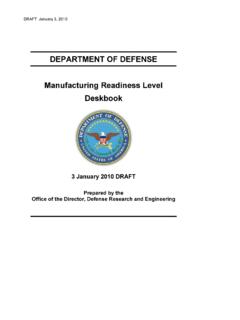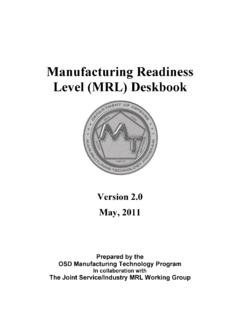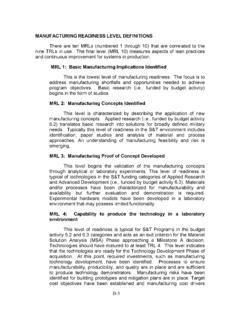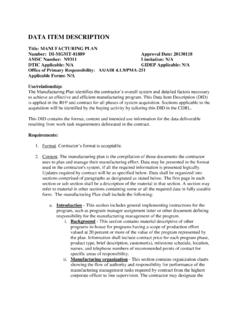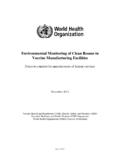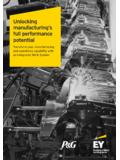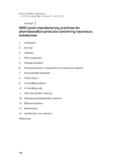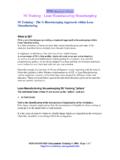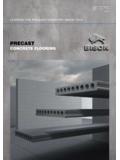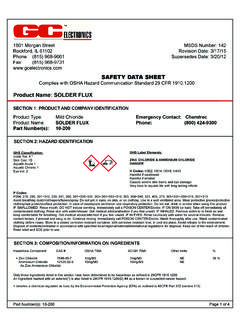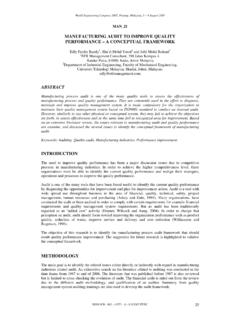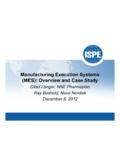Transcription of Manufacturing Readiness Assessment (MRA) …
1 Rev _____ DEPARTMENT OF DEFENSE _____ Manufacturing Readiness Assessment (MRA) Deskbook 2 May 2009 Prepared by the Joint Defense Manufacturing Technology Panel (JDMTP) Version This version of the MRA Deskbook will support DoD policy and guidance DRAFT Rev CONTENTS Executive Summary .. ES-1 1. Introduction .. 1-1 Background .. 1-1 2. Manufacturing Readiness Levels (MRLs).. 2-1 Background .. 2-1 MRLs and Basic Manufacturing Readiness Level Definitions .. 2-2 Detailed MRL Thread Definitions .. 2-6 3. MRLs and the Acquisition Life Cycle 3-1 Introduction .. 3-1 Manufacturing Readiness in the S&T Environment .. 3-2 Manufacturing Readiness in the Acquisition Environment .. 3-3 Pre-Materiel Development Decision .. 3-3 Materiel Solution Analysis Phase.
2 3-4 Technology Development Phase .. 3-6 Engineering and Manufacturing Development Phase .. 3-8 Production & Deployment Phase .. 3-10 Low Rate Initial Production .. 3-11 Full Rate Production .. 3-12 4. Manufacturing Readiness Assessments (MRAs) .. 4-1 An Introduction to the MRA .. 4-1 Basic Steps in an MRA .. 4-2 Orientation of Program Personnel .. 4-3 Planning and Preparation .. 4-3 Rev Conducting the MRA .. 4-7 Finalizing the MRA Report .. 4-10 Development of a Manufacturing Maturation Plan (MMP) .. 4-11 5. Manufacturing Risk Management .. 5-1 Identifying Risk Areas and Developing Mitigation Plans .. 5-1 Best Practices for S&T Managers .. 5-2 Best Practices for Acquisition Managers .. 5-3 Manufacturing Risk 5-4 6. Applying MRLs in Contract Language.
3 6-1 Introduction .. 6-1 MRAs & MRLs in RFP Language for Competitive RFPs .. 6-1 MRAs in RFP Language for Source Selections .. 6-2 SOO Language for all RFPs .. 6-3 MRA SOW Language for Contracts .. 6-3 Summary .. 6-4 Appendices A. DoD Manufacturing Readiness Level Definitions .. A-1 B. Detailed MRL Definitions (Threads Matrix) .. B-1 C. Manufacturing Readiness Criteria for Systems Engineering Reviews .. C-1 D. Resources available through the Defense Acquisition University Community of Practice Website .. D-1 Rev ES-4 Executive Summary The body of this document is a concise description of suggested best practices, responsibilities, roles, and procedures for applying Manufacturing Readiness Level (MRL) criteria to the Department of Defense acquisition and science and technology communities.
4 The intent is to provide those involved with Manufacturing and technology development decisions a greater understanding of how MRLs fit into DoD Acquisition and Science & Technology (S and how Manufacturing Readiness Assessments (MRAs) can serve as an effective tool in assessing Manufacturing risk. The DoD acquisition system is explained in the 5000 series of Regulations and Instructions. This set of documents covers in great detail the why and how of acquisi-tion. Basically, it covers how to move a program from one phase to another, what the expectations are for each phase, and explanations of many of the pitfalls and cautions throughout the life of a program. In recent years programs have been experiencing in-creased cost, schedule, and performance problems both in development and as they enter the later production phase of acquisition to move out to the field and into opera-tional use.)
5 MRLs and MRAs were developed to help succinctly identify Manufacturing requirements and risks in a building block approach that can start in S&T, build throughout the subsequent acquisition phases and culminate in a program that is ready for production, on cost and schedule, and meets performance requirements. Matters of Manufacturing Readiness and producibility are as important to the suc-cessful development of a system as those of the Readiness and capabilities of the tech-nologies intended for the system design. Their importance has long been recognized in DoD acquisition, but emphasis by both government and industry in recent years has waned. Manufacturing risk management needs renewed emphasis during product re-alization. Effective use of MRLs and MRAs is seen as a key element of that renewal.
6 Manufacturing Readiness is the ability to harness the Manufacturing , production, quality assurance, and industrial functions to achieve an operational capability that sat-isfies mission needs in the quantity and quality needed by the warfighter to carry out assigned missions at the best value as measured by the warfighter. Best value refers to optimized performance as well as reduced cost for developing, producing, acquiring, and operating systems throughout their life Timeliness is also important. Our warfighters must maintain a clear-cut techno-logical advantage over our adversaries. This requires compressed development and acquisition cycles for rapidly advancing technologies. The ability to transition technol-ogy smoothly and efficiently from the labs, onto the factory floor, and into the field is a critical enabler for evolutionary acquisition.
7 Manufacturing Readiness is vital to success in that transition. Manufacturing Readiness properly begins in S&T, continues during the 1 Definitions in this paragraph are adapted from Deputy Under Secretary of Defense (Science and Technology), Technology Transition for Affordability: A Guide for S&T Program Managers. April 2001. Rev ES-5 Attainment of Product KnowledgeProduction,design &technologymaturityDesign &technologymaturityTechnologymaturityDev elopmentstartDODdesignreviewProductionde cisionSource: GAO-05-301 Defense Acquisitions: Assessments of Selected Major Programs GapindicatesriskGapindicatesriskGapindic atesriskSpecificprogramDesired level of knowledgeAttainment of Product KnowledgeProduction,design &technologymaturityDesign &technologymaturityTechnologymaturityDev elopmentstartDODdesignreviewProductionde cisionSource: GAO-05-301 Defense Acquisitions.
8 Assessments of Selected Major Programs GapindicatesriskGapindicatesriskGapindic atesriskSpecificprogramDesired level of knowledgeAttainment of Product KnowledgeProduction,design &technologymaturityDesign &technologymaturityTechnologymaturityDev elopmentstartDODdesignreviewProductionde cisionSource: GAO-05-301 Defense Acquisitions: Assessments of Selected Major Programs GapindicatesriskGapindicatesriskGapindic atesriskSpecificprogramDesired level of knowledgeAttainment of Product KnowledgeProduction,design &technologymaturityDesign &technologymaturityTechnologymaturityDev elopmentstartDODdesignreviewProductionde cisionSource: GAO-05-301 Defense Acquisitions: Assessments of Selected Major Programs GapindicatesriskGapindicatesriskGapindic atesriskSpecificprogramDesired level of knowledgeAttainment of Product KnowledgeProduction,design &technologymaturityDesign &technologymaturityTechnologymaturityDev elopmentstartDODdesignreviewProductionde cisionSource: GAO-05-301 Defense Acquisitions: Assessments of Selected Major Programs GapindicatesriskGapindicatesriskGapindic atesriskSpecificprogramDesired level of knowledgeAttainment of Product KnowledgeProduction,design &technologymaturityDesign &technologymaturityTechnologymaturityDev elopmentstartDODdesignreviewProductionde cisionSource: GAO-05-301 Defense Acquisitions.
9 Assessments of Selected Major Programs GapindicatesriskGapindicatesriskGapindic atesriskSpecificprogramDesired level of knowledgeAttainment of Product KnowledgeProduction,design &technologymaturityDesign &technologymaturityTechnologymaturityDev elopmentstartDODdesignreviewProductionde cisionSource: GAO-05-301 Defense Acquisitions: Assessments of Selected Major Programs GapindicatesriskGapindicatesriskGapindic atesriskSpecificprogramDesired level of knowledgeAttainment of Product KnowledgeProduction,design &technologymaturityDesign &technologymaturityTechnologymaturityDev elopmentstartDODdesignreviewProductionde cisionSource: GAO-05-301 Defense Acquisitions: Assessments of Selected Major Programs GapindicatesriskGapindicatesriskGapindic atesriskSpecificprogramDesired level of knowledgedevelopment of systems, and typically persists after a system has been in the field for a number of years.
10 Various GAO Reports all highlight the widespread schedule and cost problems experienced in DoD weapons programs in recent years. GAO-02-0701 of July 2002 Cap-turing Design and Manufacturing Knowledge Early Improves Acquisi-tion Outcomes ; GAO-03-476 of May 2003 As-sessments of Major Weapons Pro-grams ; GAO-05-301 of March 2005 As-sessments of Selected Major Wea-pon Programs ; and GAO-06-368 of April 2006 Major Weapon Systems Continue to Experience Cost and Schedule Problems under DoD s Revised Policy They cite the lack of knowledge at key decision points (technology, design, and produc-tion maturity) as one of the leading causes of these problems and show numerous spe-cific examples. The GAO strongly recommends broader use of knowledge-based deci-sion making using specific criteria at key decision points as a solution.
